Cooling your cameras is essential in fluorescence imaging because it dramatically reduces dark current noise, allowing you to detect even the faintest fluorescence signals. Lower sensor temperatures improve signal-to-noise ratio, enable longer exposure times, and enhance quantum efficiency across wavelengths. You’ll capture clearer images with better quantitative data, especially during extended imaging sessions. Different cooling technologies like Peltier and liquid nitrogen systems offer varying benefits that can transform your imaging results.
Second-Level Headings for “Why Cool Cameras Matter In Fluorescence Imaging Systems?”
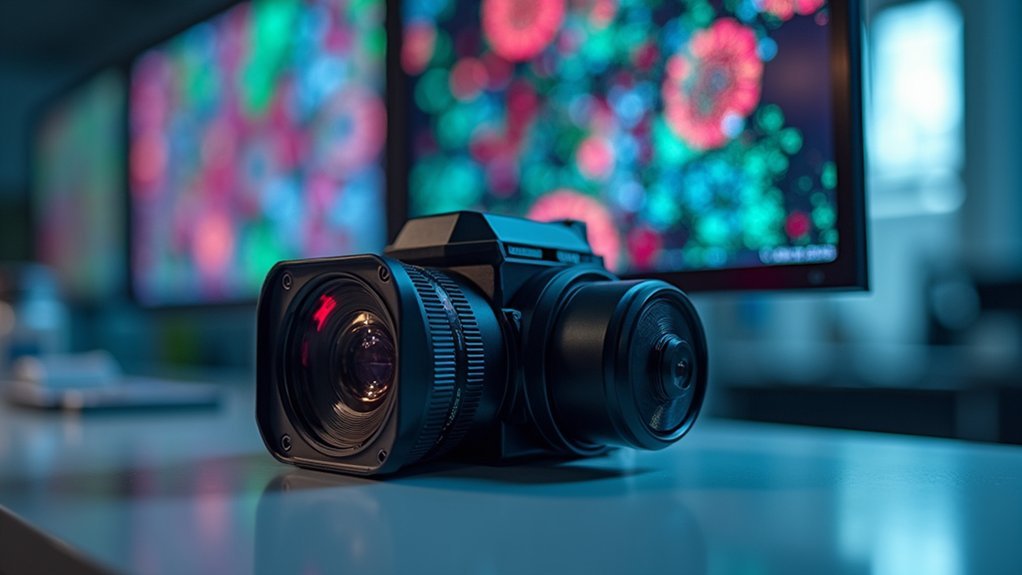
When you’re trying to capture faint fluorescence signals, temperature control becomes vital to your imaging success. Cooling the camera greatly reduces dark noise, which otherwise overwhelms weak fluorescence signals during detection.
By lowering sensor temperature through thermoelectric elements, you’ll minimize dark current that accumulates during long exposures required for low-light fluorescence. This cooling process directly improves your signal-to-noise ratio (SNR), resulting in clearer images with enhanced detail.
Even with today’s advanced sensors, active cooling remains essential for maximizing image quality in demanding applications. You’ll notice the difference particularly when working with subtle fluorescence that requires high sensitivity detection.
Additionally, proper thermal management extends your camera’s lifespan by preventing component damage from overheating—making cooling both a performance and investment consideration for serious imaging work.
The Science Behind Camera Cooling Technology
The excess heat in your imaging system generates unwanted dark current noise that can overwhelm faint fluorescence signals, greatly degrading image quality.
You’ll find several cooling technologies available, including passive heat sinks, forced-air cooling, and thermoelectric (Peltier) devices that can actively reduce sensor temperatures by up to 50°C below ambient conditions.
Your choice of cooling technology directly impacts detection sensitivity, with deeper cooling generally enabling better visualization of weak fluorophore emissions during long exposure captures.
Heat’s Impact On Signal
Although invisible to the naked eye, heat wreaks havoc on sensitive fluorescence imaging systems by generating dark current noise in camera sensors. This noise increases exponentially with temperature, directly undermining your ability to detect weak fluorescence signals.
When you’re capturing faint emissions, every photoelectron counts. Higher temperatures not only amplify dark current but also reduce your sensor’s quantum efficiency—diminishing its ability to convert photons into measurable signals. The result? Compromised image quality and decreased sensitivity precisely when you need it most.
Effective cooling methods, particularly thermoelectric cooling, can dramatically improve your signal-to-noise ratio (SNR) by minimizing thermal interference. By maintaining ideal sensor temperatures during long exposures, you’ll capture clearer fluorescence images with greater accuracy and extend your camera’s operational lifespan.
Cooling Technology Options
Modern fluorescence imaging demands effective thermal management solutions that enhance your camera’s performance.
When capturing faint fluorescence signals, you’ll need systems that minimize dark current noise and improve signal-to-noise ratio (SNR).
Thermoelectric cooling represents the most common approach, using Peltier elements to reduce sensor temperatures by several degrees Celsius without introducing mechanical vibrations.
This technology considerably decreases thermal noise, allowing for longer exposure times while maintaining image clarity.
For applications requiring maximum sensitivity, water cooling systems provide superior temperature regulation without the vibration issues associated with fans.
Thermal Noise Reduction Through Active Cooling
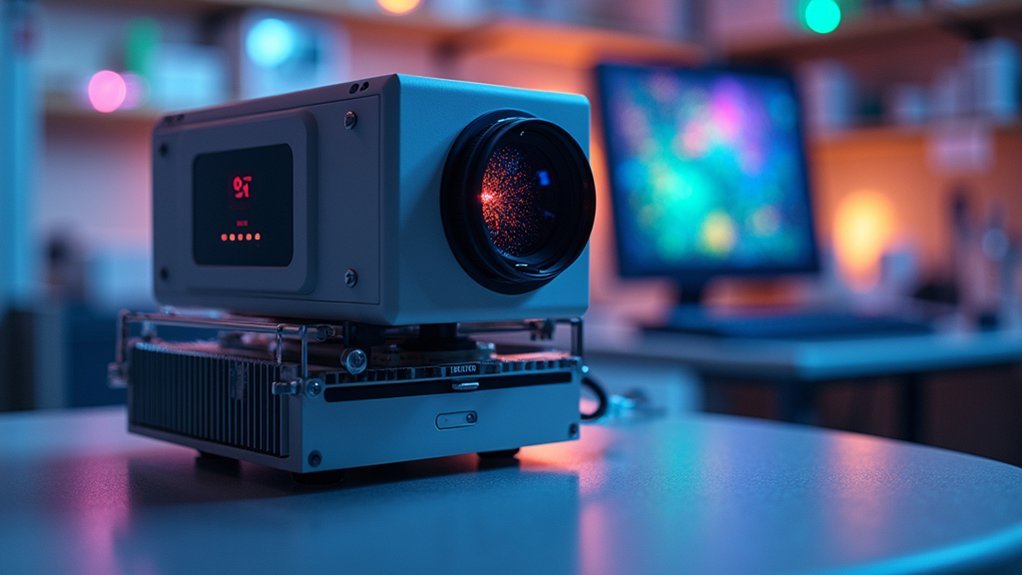
While fluorescence imaging demands exceptional sensitivity, thermal noise poses a considerable challenge in capturing clean, high-quality images. Your camera’s sensor generates dark current—unwanted electrons that increase exponentially with temperature, degrading your signal-to-noise ratio (SNR).
Active cooling technologies like thermoelectric (Peltier) and water cooling systems can dramatically reduce this thermal noise by maintaining sensor temperatures below 0°C. This cooling action decreases dark current to less than 1 electron, considerably enhancing your camera’s sensitivity to detect faint fluorescence signals.
Cooling your sensor below 0°C virtually eliminates thermal noise, revealing fluorescent signals that would otherwise remain invisible.
You’ll also benefit from the ability to use longer exposure times without noise interference, capturing weak signals that would otherwise remain undetected.
Additionally, proper cooling prevents condensation on sensor surfaces, eliminating potential image artifacts that could compromise your research results.
Enhancing Signal-To-Noise Ratio With Temperature Control
Temperature-controlled cameras greatly reduce dark noise, allowing you to detect even the faintest fluorescence signals that would otherwise be lost in thermal interference.
You’ll notice dramatically improved image clarity as cooling minimizes random electron generation, effectively increasing your signal-to-noise ratio in low-light conditions.
Maintaining consistent temperature also prevents thermal drift during extended imaging sessions, ensuring your quantitative measurements remain reliable throughout time-lapse experiments.
Dark Noise Reduction
As scientists push the boundaries of fluorescence imaging to detect increasingly faint signals, dark noise emerges as a critical limiting factor in camera performance.
When you’re capturing subtle fluorescence emissions, dark noise—generated by thermal energy within the sensor—can obscure the very signals you’re trying to detect. By cooling your camera sensor, you’ll greatly reduce this unwanted noise.
Thermoelectric (Peltier) cooling systems can decrease dark current to below 1 electron, considerably improving sensitivity in low-light conditions.
The benefits extend beyond noise reduction. Maintaining ideal sensor temperatures enhances quantum efficiency, allowing you to detect smaller changes in signal intensity against noisy backgrounds.
This temperature control creates a more stable imaging environment, elevating your signal-to-noise ratio and ultimately delivering superior image quality essential for advanced fluorescence applications.
Thermal Drift Prevention
Beyond basic cooling for noise reduction, thermal stability represents a key advancement in fluorescence imaging technology. When you maintain a consistent temperature below 20°C, you’ll prevent thermal drift that can compromise your results.
Temperature fluctuations directly impact your signal-to-noise ratio (SNR), obscuring critical details in fluorescence signals.
- Active cooling systems, particularly thermoelectric (Peltier) solutions, stabilize your camera’s temperature, eliminating variability in dark current that would otherwise degrade image quality.
- This thermal consistency allows you to confidently capture longer exposure times without worrying about temperature-induced artifacts or baseline shifts.
- Your fluorescence imaging system’s reliability improves dramatically, as the cooled detector can repeatedly capture the same signal intensity regardless of ambient conditions.
Peltier Cooling vs. Liquid Nitrogen Systems
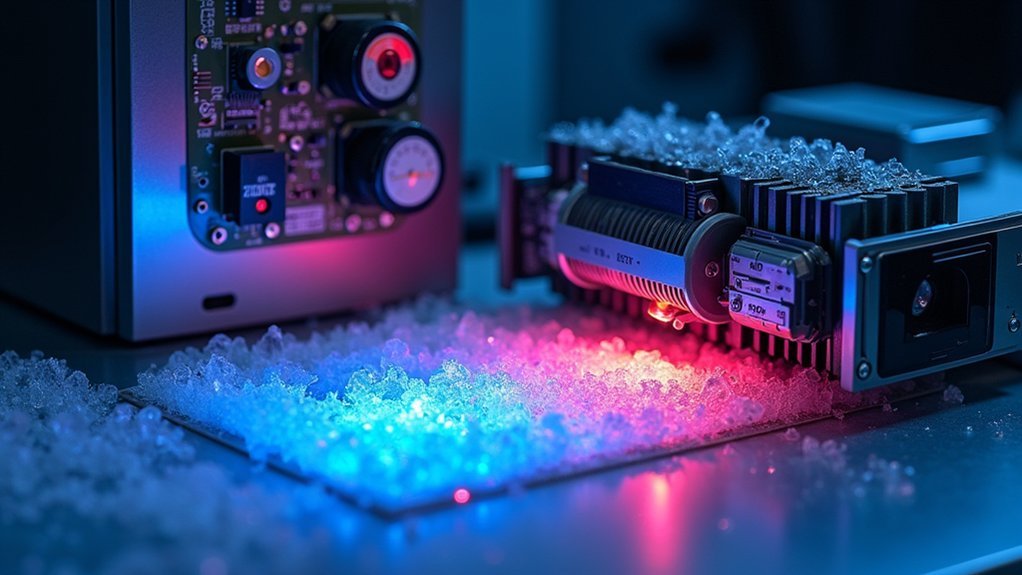
When selecting a cooling system for fluorescence imaging cameras, the choice between Peltier and liquid nitrogen technologies represents a critical decision that impacts both performance and practicality.
Peltier cooling offers operational convenience, reducing dark current noise by cooling sensors to around -20°C to -30°C, which greatly improves signal-to-noise ratios. You’ll find these systems easier to implement in standard setups without specialized equipment.
Thermoelectric Peltier systems deliver practical cooling performance without the complexities of cryogenic alternatives.
In contrast, liquid nitrogen cooling achieves temperatures near -196°C, delivering ultra-low noise performance and enabling extended exposure times without image degradation.
While requiring specialized handling protocols, these systems provide maximum sensitivity that’s beneficial for high-end research applications.
Your selection should balance practical considerations against your specific fluorescence imaging requirements, determining whether the extreme sensitivity of liquid nitrogen justifies its additional complexity and cost.
Impact of Cooling on Quantum Efficiency
When you cool your imaging sensors, you’ll see dramatic improvements in quantum efficiency across different wavelengths, as temperature directly shapes QE curves.
You can optimize spectral sensitivity by maintaining your camera at specific temperatures that match your fluorophores’ emission profiles.
Cold sensors maximize photon detection by reducing thermal noise, allowing you to capture even the faintest fluorescence signals that would otherwise be lost in warmer systems.
Temperature Effects QE Curves
Although many factors influence camera performance in fluorescence imaging, temperature stands out as a critical parameter affecting quantum efficiency curves. When you cool your camera sensor, you’re directly enhancing its ability to detect weak fluorescent signals by reducing thermal noise and dark current.
- Lower temperatures shift the peak sensitivity toward longer wavelengths, potentially matching better with your specific fluorescent dyes.
- Cooling allows your camera to operate closer to its theoretical QE limits, maximizing the usable signal from fluorescence emissions.
- Active cooling methods maintain high quantum efficiency across broader wavelength ranges, improving measurement reliability.
The relationship between temperature and QE isn’t just theoretical—it translates to practical improvements in sensitivity that can make the difference between detecting or missing critical fluorescence imaging data.
Optimizing Spectral Sensitivity
Despite being often overlooked, cooling your camera sensor represents one of the most effective ways to enhance spectral sensitivity in fluorescence imaging. When you reduce sensor temperature, you’re directly combating thermal noise that obscures weak fluorescence signals in low-light conditions.
Your camera’s quantum efficiency improves dramatically with cooling, allowing detection of subtle spectral variations that would otherwise be lost in noise. Active cooling methods like thermoelectric cooling maintain ideal sensor temperatures, enhancing signal-to-noise ratio and preventing dark current from degrading spectral response.
This cooling advantage becomes particularly critical when you’re capturing faint fluorescent emissions across different wavelengths. By keeping your sensor cool, you’ll not only extend its operational life but also achieve consistent spectral sensitivity across your imaging experiments, ensuring reliable data collection from even the weakest fluorescent samples.
Cold Sensors Maximize Detection
The relationship between sensor temperature and quantum efficiency (QE) represents one of the most powerful tools in your fluorescence imaging arsenal. By cooling your camera’s sensor, you’ll greatly reduce dark current noise, markedly enhancing your signal-to-noise ratio (SNR) and boosting detection sensitivity of weak fluorescent signals.
- Lower sensor temperatures improve QE by minimizing thermal noise, allowing you to capture fainter emissions that would otherwise be lost in the noise floor.
- Active cooling systems maintain consistent temperatures during prolonged imaging sessions, ensuring reliable detection throughout your experiments.
- Cooler sensors enable longer exposure times without image degradation, helping you collect more photons from dim samples.
When you implement effective cooling strategies, you’ll achieve clearer images and more accurate quantification, especially in challenging low-light applications where every photon counts.
Extended Exposure Times and Long-Term Imaging
When capturing weak fluorescence signals becomes challenging, extended exposure times emerge as a critical strategy for researchers. You’ll achieve higher signal-to-noise ratio (SNR) as longer exposures allow more photons to accumulate from dim specimens. However, extended exposure times introduce a significant challenge: dark current noise increases with duration.
Cooling cameras effectively counters this problem, especially during long-term imaging when thermal noise accumulates and can ruin your results.
| Exposure Duration | Cooling Benefit | Application Example |
|---|---|---|
| Short (<1s) | Minimal noise reduction | Bright specimen imaging |
| Medium (1-10s) | Moderate dark current suppression | Standard fluorescence |
| Long (10-60s) | Significant SNR improvement | Weak fluorophores |
| Extended (>60s) | Critical for data integrity | Live-cell imaging, time-lapse |
Preserving Sample Integrity With Reduced Light Requirements
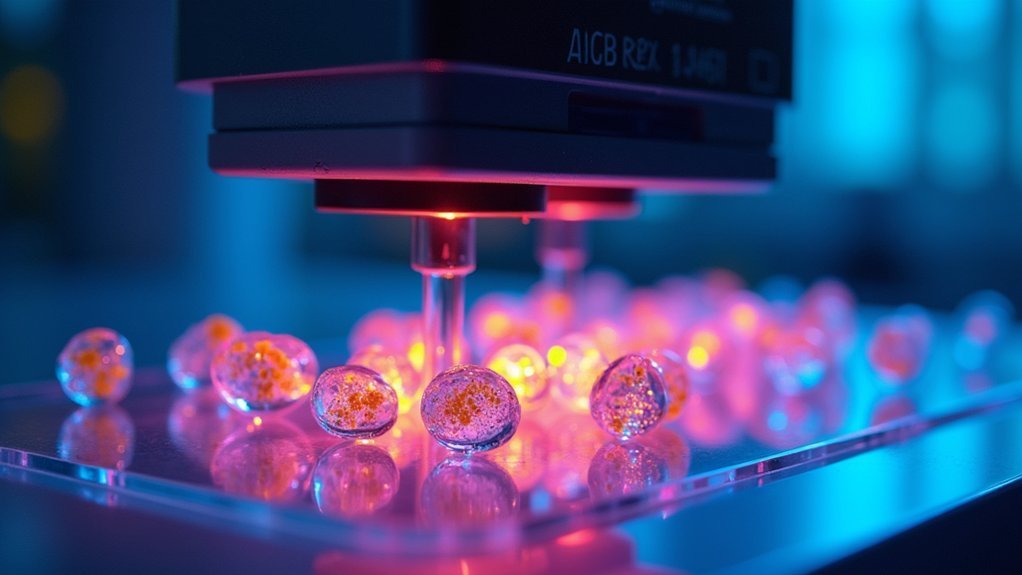
While extended exposure times boost signal collection, they come with a significant drawback for delicate specimens. By cooling your fluorescence camera system, you’re directly addressing this challenge. Cooled sensors dramatically reduce dark current noise, improving your signal-to-noise ratio without requiring intense light exposure that damages sensitive samples.
- You’ll capture clearer images of light-sensitive specimens like live cells, as the enhanced quantum efficiency detects weak fluorescence signals with minimal illumination.
- Your delicate fluorescent markers remain viable longer, experiencing less photobleaching due to the reduced light requirements.
- You can observe subtle fluorescence changes that would otherwise be masked by thermal noise in uncooled systems.
This preservation of sample integrity isn’t just about better images—it enables experiments that would be impossible if specimens degraded under traditional imaging conditions.
Dark Current Minimization in Cooled Sensors
Because thermal agitation naturally generates electron flow in camera sensors even without light, cooling your imaging system becomes critical for capturing pristine fluorescence images. When you’re working with faint fluorescence signals, dark current noise can overwhelm your data.
| Cooling Impact | Benefit to Fluorescence Microscopy |
|---|---|
| Reduces dark current | Reveals weak signals otherwise lost in noise |
| Enables longer exposures | Captures more photons from dim samples |
| Improves signal-to-noise ratio | Enhances quantitative measurements |
| Lowers to <1 electron/pixel | Preserves data integrity in low-light conditions |
| Maintains sample viability | Reduces photobleaching and phototoxicity |
Thermoelectric cooling methods can dramatically enhance image quality by actively cooling sensors, making them indispensable for life sciences applications where detecting subtle fluorescent signals determines experimental success. You’ll achieve considerably more reliable results when thermal noise no longer masks your biological signals.
Comparative Performance: Room Temperature vs. Cooled Cameras
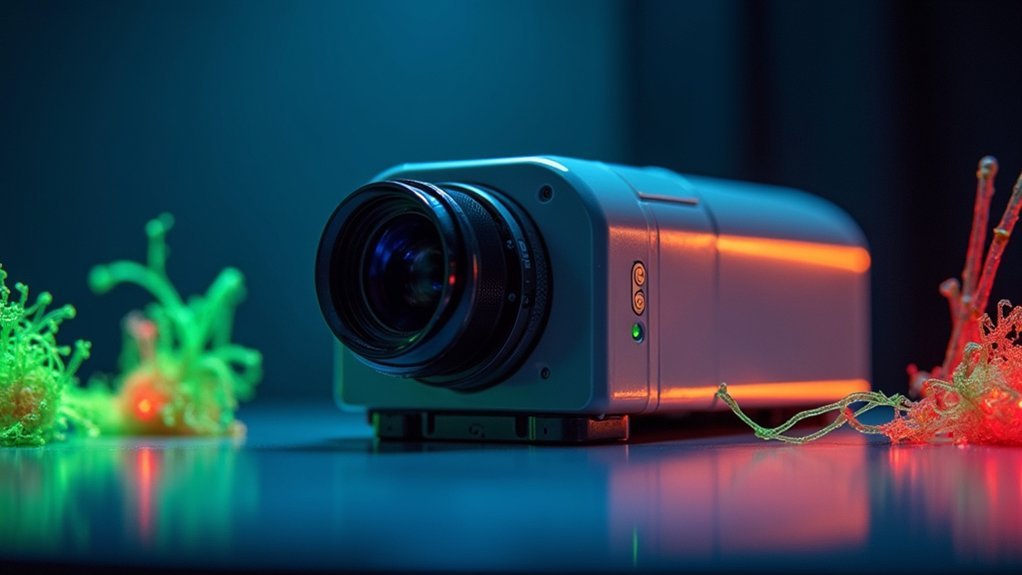
The performance gap between room temperature and cooled cameras becomes starkly apparent in fluorescence imaging applications.
When you’re capturing faint fluorescence signals, dark current accumulates rapidly at room temperature, especially during longer exposure times, degrading your SNR dramatically. Cooled cameras, maintaining temperatures around -20°C or lower, deliver superior results by effectively suppressing this thermal noise.
- You’ll achieve notably higher sensitivity with cooled cameras, allowing detection of weak fluorescence signals that would otherwise be lost in thermal noise.
- Your dynamic range expands considerably, improving quantification accuracy across varying signal intensities.
- You can utilize extended exposure times without the performance penalties that plague room temperature sensors.
This performance differential makes cooled cameras essential for demanding fluorescence imaging applications where precision and sensitivity are paramount.
Integration of Cooling Systems in Modern Microscopy
Modern microscopy has embraced advanced cooling technologies as essential components rather than mere optional accessories.
When you’re capturing fluorescence images, thermoelectric (Peltier) elements actively reduce your camera’s sensor temperature, dramatically decreasing dark current noise that would otherwise compromise image quality.
You’ll notice the difference primarily during long exposure times, where cooled fluorescence cameras maintain exceptional signal-to-noise ratio (SNR) even as imaging sessions extend for hours. This consistency isn’t just about prettier pictures—it’s about preventing thermal artifacts that could invalidate your research data.
In today’s sophisticated imaging setups, cooling systems aren’t isolated components but integrated elements of the entire microscopy ecosystem, ensuring reliable performance across challenging conditions.
Whether you’re conducting live-cell studies or tracking subtle fluorescent signals, these systems provide the temperature stability your applications demand.
Frequently Asked Questions
What Camera Is Best for Fluorescence Microscopy?
For fluorescence microscopy, you’ll want a monochrome camera with high quantum efficiency. Consider sCMOS or advanced CMOS sensors with low noise, like the INFINITY-3S-1 from Lumenera, which offers excellent sensitivity for fluorescence applications.
Why Do Cameras Need Cooling?
You’ll need cooling in cameras to reduce thermal noise, especially during long exposures. It lowers dark current, improves your signal-to-noise ratio, and helps you capture clearer images with better sensitivity.
What Are the Key Parameters That Can Be Gained Through Fluorescence Microscopy?
You’ll gain essential parameters through fluorescence microscopy including spatial resolution, sensitivity, signal-to-noise ratio, dynamic range, and temporal resolution—all enabling you to visualize and quantify specific cellular components in real-time with precision.
What Are the Limitations of Fluorescence Microscopy?
You’ll face limitations in fluorescence microscopy including low camera sensitivity, various noise types, autofluorescence interference, quantum efficiency constraints, and insufficient frame rates for capturing dynamic cellular processes accurately.
In Summary
You’ll find that cool cameras dramatically improve your fluorescence imaging results by reducing thermal noise and minimizing dark current. When you’ve invested in cooling technology, you’re effectively enhancing signal-to-noise ratios and preserving sensitive samples. Whether you’re choosing Peltier or liquid nitrogen systems, remember that temperature control isn’t just a luxury—it’s essential for capturing the high-quality, accurate data your research demands.

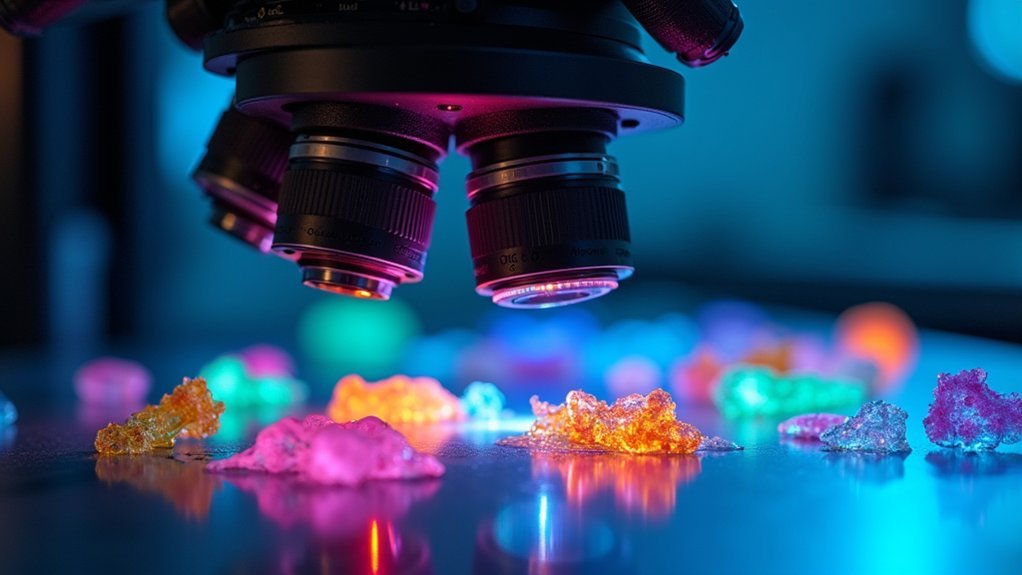



Leave a Reply